Posted by Anita on 11.30.07 7:02 AM
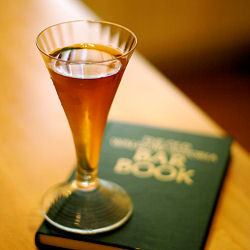 A few months ago, the New Yorker ran a ‘briefly noted’ blurb about Michael Lerner’s book Dry Manhattan: Prohibition in New York City. The review’s blasé tone must have dissuaded me from rushing out to buy a copy; instead, I patiently waited months for my chance to read our library’s single circulating print.
A few months ago, the New Yorker ran a ‘briefly noted’ blurb about Michael Lerner’s book Dry Manhattan: Prohibition in New York City. The review’s blasé tone must have dissuaded me from rushing out to buy a copy; instead, I patiently waited months for my chance to read our library’s single circulating print.
Had I known what a compelling read Dry Manhattan would be, I probably would have spent 20 bucks for the luxury of getting my hands on it sooner. True, it’s a bit scholarly, weighed down with inconvenient end-notes and a tendency toward expository repetition. But I can forgive the academic author’s shortcomings, given how entertaining the final story becomes, even when you know the ending.
Despite his geographic focus on New York City, Lerner illuminates the entire era by throwing a cosmopolitan light on the social changes that led both to Prohibition and its eventual Repeal. Although the book steers clear of drawing any overt parallels to current politics, readers who possess even a passing familiarity with modern-day prohibition movements — foie gras bans and the war on medical cannabis come to mind — will recognize plenty of eerie echoes from 80 years past. The story here makes a stark reminder of how a vocal, conservative, puritan minority swept away the freedoms of an entire country as their city-dwelling counterparts complacently boasted “it can never happen here”. Until it did… and it stayed that way for 13 long, dry years.
Honestly, it’s enough to send you straight to the bar in search of a sedative.
Perusing my library for appropriate Prohibition-era cocktails to salve my nerves, I stumbled upon a drink called the Ampersand in the Old Waldorf-Astoria Bar Book. How could I help but love a drink named after my favorite typographical glyph? (I suppose I just outed myself as a font geek. So be it.) Plus, it just sounds like a winner: Gin, brandy, sweet vermouth, plus a pair of orange-scented grace notes… What’s not to like?
But why “Ampersand”?
Although the compendium is rife with anecdotes — no great surprise, given that it was laid down by the hotel’s official historian — the origins of this particular drink’s name are lost to the mists of time. It’s possible that the typographical moniker’s a nod to Martini & Rossi, the still-popular Italian sweet vermouth, and one of the drink’s key ingredients.
Whatever the namer’s original intent, it seems particularly appropriate as cocktail bloggers around the world are celebrating both this month’s Mixology Monday & this year’s Repeal Day festivities next week. Wednesday evening, be sure to raise a glass of your favorite beverage in honor of those who fought the good fight in the 1930s, restoring the pursuit of mixological happiness to us all.
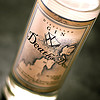



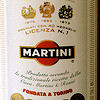
Ampersand
1 oz Old Tom gin (see note)
1 oz brandy
1 oz Italian sweet vermouth
2 dashes orange bitters
orange curaçao, to finish
In an ice-filled mixing glass, stir the gin, brandy, vermouth, and bitters until very cold. Strain into a chilled cocktail glass, then add two drops of curaçao.
Note: Old Tom was a sweetened gin of yore, a popular ingredient in many pre-Prohibition cocktail recipes. Although there are no ready sources for such a beast, fruit-derived gins such as G’vine are not bad stand-ins. Alternately, David Wondrich recommends slightly sweetened Plymouth or Junipero as acceptable substitutes; a drop or two of simple syrup seemed to do the trick in the Ampersand samples we tried. Given its lore, I suspect the original Old Tom gins were a fair deal harsher than anything on the shelves today, but we’re going for delicious approximations here, rather than slavish authenticity.
My neighbor Erik (proprietor of Underhill Lounge) was kind enough to let us sample from his personal stash of Death’s Door gin, a product that may be the closest modern Old Tom equivalent. Its flavor is noticeably sweet, a trait that the distillers assured Eric was intended rather than accidental. Alas, it’s not widely available outside the upper Midwest, but we didn’t find a drastic difference in mixed drinks made with Death’s Door compared with those made from sweetened dry gins.
bar culture, Drink of the Week, drinks, holidays & occasions, literary, Mixology Monday, other blogs, recipes
15 Comments »




Posted by Cameron on 09.21.07 7:07 AM
 “The history of the world, my sweet;
“The history of the world, my sweet;
Is who gets eaten and who gets to eat.”
— Sweeney Todd
We’re headed to the thyuh-tuh tonight for a performance of “Sweeney Todd: The Demon Barber of Fleet Street.” Here’s the short version: Crazy barber kills people, crazy restaurateur bakes them into meat pies, hilarity ensues.
I’ve loved the show since I first heard the music as an impressionable youth. How can you not like a musical with a showstopping number that muses about how different people would taste if you served them wrapped a tender, flaky crust?
While you digest that macabre notion, here’s a little something to wash it down. We’ve tinkered with the recipe a tad, but the name and the basic ingredients are original.





Sweeney’s Cocktail
1 1/2 oz brandy
1/2 oz pineapple juice
1/8 oz Maraschino liqueur (or to taste)
1/4 to 1/8 oz lemon juice
3 dashes Angostura bitters
Shake all ingredients well with ice. Strain into a chilled cocktail glass. Garnish with lemon twist, if desired.
Drink of the Week, drinks, literary, recipes
12 Comments »




Posted by Anita on 06.07.07 11:02 PM
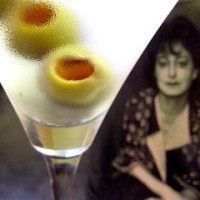 I like to have a martini,
I like to have a martini,
Two at the very most.
After three I’m under the table,
After four I’m under my host.
Michael at A Dash of Bitters reminds us that tonight marks the 40th anniversary of Dorothy Parker‘s demise. She died not, as one would expect (and she might have preferred) from suicide or cirrhosis, but from a heart attack in old age. Her modern notoriety hinges on witty bon mots and wry verse, but in her heyday she was nothing short of a cultural icon, a woman who led trends and set tongues a-wagging.
Mrs. Parker found fame as Vanity Fair‘s drama critic, and later reviewed books for the New Yorker under the sobriquet “Constant Reader”. She penned a pile of short stories, and her semi-autobiographical Big Blonde (although she was a dainty brunette) won the O. Henry prize for short fiction. Later, she and her second husband Alan Campbell became a sought-after Hollywood screenwriting team; the original, Oscar-winning A Star is Born topped their credits.
Although much of the Parker mystique hinges on her wisecracking party-girl persona, in fact she was a near-teetotaler for part of her life. In her twenties, she hardly drank at all. Her biographers tell us that she weathered the ironic excesses Prohibition better than many. One or two drinks a night would be plenty for her, in an era and milieu when an evening on the town typically started at sundown and lasted until breakfast at dawn.
As the years progress, the drinks get stiffer: Dottie’s small beer on the bar beside her pal Robert Benchley‘s large Scotch, an Orange Blossom at the speakeasy, Manhattans at her country house, and, eventually, all-night parties fueled by pitcher after pitcher of Martinis (with no food!). Sweet misery — imagine the mornings after those night-befores:
Drink and dance and laugh and lie,
Love, the reeling midnight through,
For tomorrow we shall die!
(But, alas, we never do.)
In the Algonquin era, the Martini had not yet suffered from modern innovation. None of the Round Table denizens would have recognized the drink as anything other than a well-chilled mixture (always stirred, never shaken) of five or so parts gin to one part dry vermouth, and a dash of orange bitters. No gin, no Martini. If olives weren’t at hand, a simple lemon twist could be substituted, but even this would be noted as a touch unorthodox. One can only imagine what the Vicious Circle would make of so-called Martinis of chocolate, sour apple, or (God forbid) vodka.
Martinis made in the classic style fell out of fashion through the years; some speculate that a lack of proper bitters hastened the drink’s metamorphosis into little more than a bruising-cold glass of gin. Thankfully, renewed interest in classic cocktails means there’s an abundance of delectable orange bitters to choose from today. Our house brand is Regan’s, with a bottle of Hermes on hand as a pleasant alternative. But you’re more likely to find Fee Brothers’ in your local liquor establishment, and that will certainly do just fine. I daresay that once you try your Martini made this way, the modern rendition will seem rather flat and unappealing.
Now, what’s stopping you? As Mr. Benchley would say: Get out of that wet coat and into a dry martini.


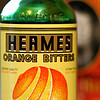
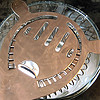

Classic Martini
1-1/2 oz gin
1/2 oz dry vermouth
1 dash orange bitters
Stir with ice, and strain into a chilled cocktail glass. Garnish with olives or a lemon twist.
Drink of the Week, drinks, literary
5 Comments »




Posted by Cameron on 11.30.06 11:56 PM
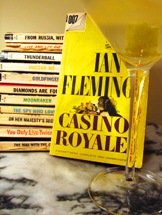
“When I’m–er–concentrating, I never have more than one drink before dinner. But I do like that one to be large and very strong and very cold and very well-made.”
–James Bond, Casino Royale by Ian Fleming
Was ever a character from popular literature more poorly served by Hollywood than James Bond? We all know the silver screen buffoonery: arch, cartoonish cardboard cutouts with sapphire blue eyes. Hit the tape marks and luxuriate in the JiggleVision. Dress like a peacock, shake the gadgets. Secret agent? Bah. This is a man so monomaniacal in his habits that even his enemies know his drink preference.
But on the page, Ian Fleming’s international spy is a different man. He prefers a low profile. He is thoughtful and specific, driven by both personal inclination and professional urgency. He is a hopeless romantic and desperately human. Over the course of the original thirteen novels and a few short stories, Bond falls deeply in love, again and again, in the face of brutal heartbreak. He takes great pains to remain anonymous and alive in a dangerous trade, and he is intimately, passionately connected with the day-to-day business of living.
“You must forgive me,” he said. “I take a ridiculous pleasure in what I eat and drink. It comes partly from being a bachelor, but mostly from a habit of taking a lot of trouble over details. It’s very pernickety and old-maidish really, but then when I’m working I generally have to eat my meals alone and it makes them more interesting when one takes trouble.”
“Shaken, not stirred,” marketing-friendly bull***t be damned. Bond drinks whatever is appropriate, local, and good. In Turkey, it’s Kavaklidere, “a rich coarse burgundy like any other Balkan wine”. In the Caribbean: gin, tonic and lime (you can take the Boy out of the Empire…). Champagne? Just watch the man go. And when the vodka comes out, our man James drops pepper on top, for practical and aesthetic reasons:
‘It’s a trick the Russians taught me that time you attached me to the Embassy in Moscow,’ apologized Bond. ‘There’s often quite a lot of fusel oil on the surface of this stuff –at least there used to be when it was badly distilled. Poisonous. In Russia, where you get a lot of bath-tub liquor, it’s an understood thing to sprinkle a little pepper in your glass. It takes the fusel oil to the bottom. I got to like the taste and now it’s a habit. But I shouldn’t have insulted the club Wolfschmidt,’ he added with a grin.
But there’s only one drink that Bond invented, and it’s not the one you might think. The medium-dry vodka martini may have launched a thousand ships, but the Vesper, introduced in Casino Royale, is the original–really, the only–Bond drink. Not surprisingly, it’s a much more interesting cocktail:
“A dry Martini,” he said. “One. In a deep champagne goblet.”
“Oui, Monseiur.”
“Just a moment. Three measures of Gordon’s, one of vodka, half a measure of Kina Lillet. Shake it very well until it’s ice-cold, then add a large thin slice of lemon-peel. Got it?”
In The Book of Bond, Kingsley Amis argues that the mixture is a mistake, as that quantity of Kina Lillet would have made the cocktail undrinkably bitter. We will never know for sure, as the formula of Lillet was changed in 1986. Happily, the new Lillet works like a charm.
Made with one “measure” equaling one ounce, the Vesper is indeed a large, strong, cold cocktail. The vodka takes the edge off the gin and contributes a bit of sweetness which is reinforced by the Lillet and the lemon.
“This drink’s my own invention. I’m going to patent it when I can think of a good name.”
As might be expected, James can only find a bad one. This drink’s name comes from Vesper Lynd, a female spy who Bond initially ignores but then falls in love with. Vesper turns out to be a double-agent working for both the Russians and the British while in France. It’s a combination that echoes the ingredients of the cocktail that eventually bears her name: vodka, gin, and vermouth.
The Vesper
3 ounces gin
1 ounce vodka
1/2 ounce Lillet
Shake with ice and strain into a cocktail glass (or champagne coupe, if you have one). Garnish with a large, thin slice of lemon peel. Bet large. Tip the chef de partie. Flirt with Moneypenny. Get out before they use the laser.
Drink of the Week, drinks, literary, recipes
10 Comments »




Posted by Anita on 10.01.06 1:35 PM
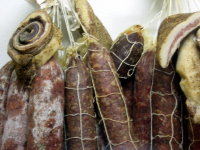 If you’ve read Bill Buford’s Heat, you know about Dario, the Tuscan butcher who taught Mario Batali the arcane mysteries of traditional Italian meat-curing. What you may not know is that Dario also taught Mario’s pop, Armandino, much of what he knows about the art of salumi. There’s even a Dario namesake salami on the menu at Salumi, Batali Senior’s pint-size salumeria near Pioneer Square.
If you’ve read Bill Buford’s Heat, you know about Dario, the Tuscan butcher who taught Mario Batali the arcane mysteries of traditional Italian meat-curing. What you may not know is that Dario also taught Mario’s pop, Armandino, much of what he knows about the art of salumi. There’s even a Dario namesake salami on the menu at Salumi, Batali Senior’s pint-size salumeria near Pioneer Square.
A zillion other bloggers have written about the heady pleasures of Salumi — it seems like dozens of Bay Area folks have trekked to Seattle in the past few weeks, and they all made their dutiful pilgrimage to the altar of pig. And given the breadth of our own ramblngs on the subject over the years, I don’t have a whole lot new to report.
But, following our homesick hearts, we found ourselves casting about for lunch options of Wednesday, and for once we were (a) in town during the week and (b) not otherwise occupied during the slender slice of time that Salumi is open for business.
We shuffled in at the end of the lunch rush, amazed to find one lone Muffo sandwich — Salumi’s take on the muffaletta — waiting for Cameron. Lucky me, I managed to get the very last trio of meatballs (along with some glorious house-made mozzarella) in my own sandwich. Mindful of our upcoming dinner at Union, we grabbed a table, ate exactly half of our sandwiches, and dutifully wrapped up the leftovers. Resisting the siren song of cured meats is never easy, but we both pratcially whimpered as we shuttled the sandwiches back to the hotel mini-fridge.
Armandino’s Salumi
309 3rd Avenue South
Seattle, WA 98104
206.621.8772
literary, lunch, Seattle
2 Comments »




Posted by Cameron on 08.18.06 6:13 PM
 Somehow, this became the week of braised meat. In addition to the oxtails mentioned previously, I made carnitas.
Somehow, this became the week of braised meat. In addition to the oxtails mentioned previously, I made carnitas.
I didn’t really grok carnitas until very recently, and I certainly wasn’t capable of cooking good ones until I found this recipe. It’s my all-time favorite Internet find for three reasons: It’s practically idiot-proof, it really works, and right in the middle it reminds you to call your mom.
That said, I often feel odd when I cook carnitas. I live near the Mission district in San Francisco, and there are roughly 2.3 million taquerias within a mile of my house. In fact, some of the best carnitas that I’ve ever had are at the taqueria that Anita and I consider our “local.” For an investment of five minutes and two dollars paid to a local business, I can get a carnitas taco that doesn’t have to step aside for anyone. Compare that with $15 or more, plus five hours of cooking. Given, it’s easy time that you can do other things with and it makes the house smell great, but five hours is five hours.
This is the same kind of thinking that eventually made me pull the plug on brewing my own beer. The scale was a little different: three days of work scattered across six or eight weeks of waiting, plus time spent cleaning and storing the gear. But the theory was the same, and the argument was completely insupportable when I could go down to the store and buy a six-pack from local boys who done good.
But what I suspect it comes down to is that I like to do things that I’m good at, even if they’re completely superfluous. Much to my chagrin — as it seems like something that a competent man should be able to do — I was never very good at brewing beer. But I can say with a total lack of modesty that my carnitas kick ass.
beer, cooking, literary, meat, Mexican, The Mission
2 Comments »




 A few months ago, the New Yorker ran a ‘briefly noted’ blurb about Michael Lerner’s book Dry Manhattan: Prohibition in New York City. The review’s blasé tone must have dissuaded me from rushing out to buy a copy; instead, I patiently waited months for my chance to read our library’s single circulating print.
A few months ago, the New Yorker ran a ‘briefly noted’ blurb about Michael Lerner’s book Dry Manhattan: Prohibition in New York City. The review’s blasé tone must have dissuaded me from rushing out to buy a copy; instead, I patiently waited months for my chance to read our library’s single circulating print.














 I like to have a martini,
I like to have a martini,





 If you’ve read Bill Buford’s
If you’ve read Bill Buford’s